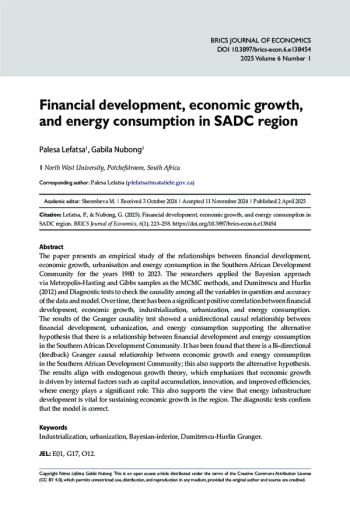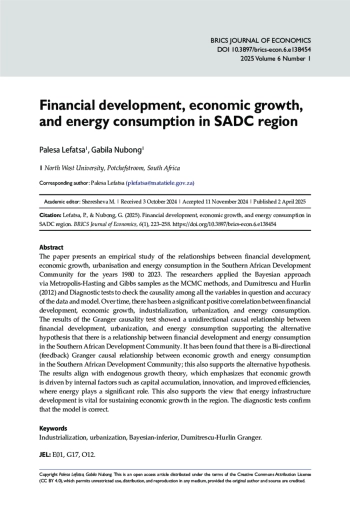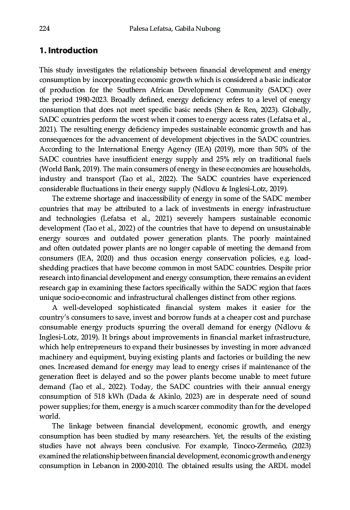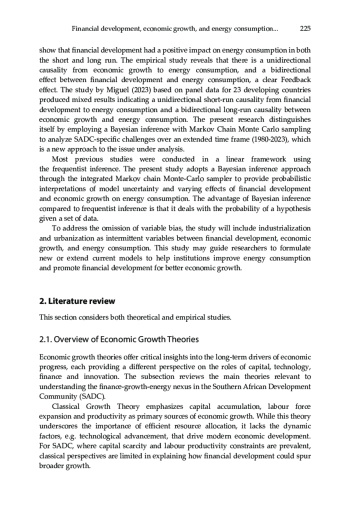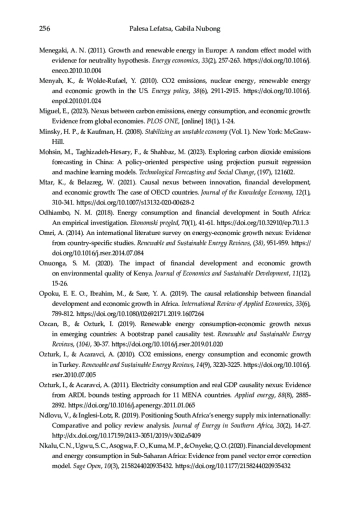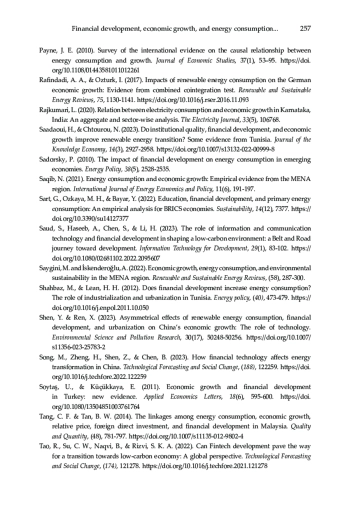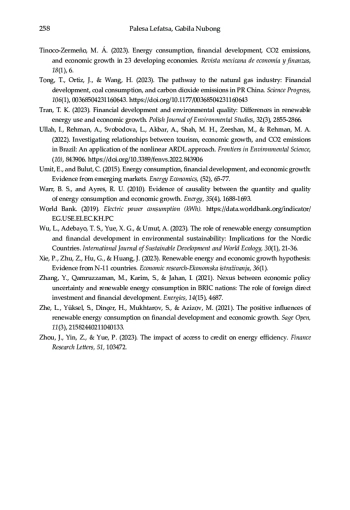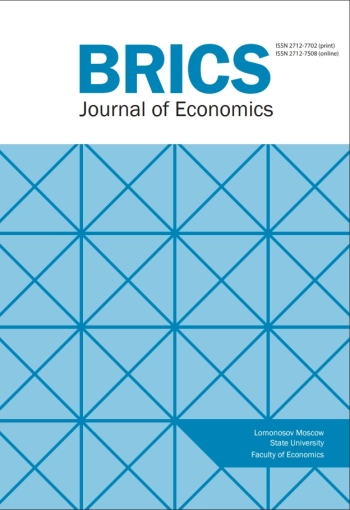The paper presents an empirical study of the relationships between financial development, economic growth, urbanisation and energy consumption in the Southern African Development Community for the years 1980 to 2023. The researchers applied the Bayesian approach via Metropolis-Hasting and Gibbs samples as the MCMC methods, and Dumitrescu and Hurlin (2012) and Diagnostic tests to check the causality among all the variables in question and accuracy of the data and model. Over time, there has been a significant positive correlation between financial development, economic growth, industrialization, urbanization, and energy consumption. The results of the Granger causality test showed a unidirectional causal relationship between financial development, urbanization, and energy consumption supporting the alternative hypothesis that there is a relationship between financial development and energy consumption in the Southern African Development Community. It has been found that there is a Bi-directional (feedback) Granger causal relationship between economic growth and energy consumption in the Southern African Development Community; this also supports the alternative hypothesis. The results align with endogenous growth theory, which emphasizes that economic growth is driven by internal factors such as capital accumulation, innovation, and improved efficiencies, where energy plays a significant role. This also supports the view that energy infrastructure development is vital for sustaining economic growth in the region. The diagnostic tests confirm that the model is correct.
Идентификаторы и классификаторы
This study investigates the relationship between financial development and energy consumption by incorporating economic growth which is considered a basic indicator of production for the Southern African Development Community (SADC) over the period 1980-2023. Broadly defined, energy deficiency refers to a level of energy consumption that does not meet specific basic needs (Shen & Ren, 2023). Globally, SADC countries perform the worst when it comes to energy access rates (Lefatsa et al., 2021). The resulting energy deficiency impedes sustainable economic growth and has consequences for the advancement of development objectives in the SADC countries. According to the International Energy Agency (IEA) (2019), more than 50% of the SADC countries have insufficient energy supply and 25% rely on traditional fuels (World Bank, 2019). The main consumers of energy in these economies are households, industry and transport (Tao et al., 2022). The SADC countries have experienced considerable fluctuations in their energy supply (Ndlovu & Inglesi-Lotz, 2019).
Список литературы
- Abu-Bader, A., & Abu-Qarn, A. S. (2008). Financial development and economic growth: The Egyptian experience. Journal of Policy Modelling, 30(5), 887–898.
- Adeel-Farooq, R. M., Raji, J. O., & Qamri, G. M. (2023). Does financial development influence the overall natural environment? An environmental performance index (EPI) based insight from the ASEAN countries. Environment, Development and Sustainability, 25(6), 5123-5139. https://doi.org/10.1007/s10668-022-02258-x
- Ahmed, S. M., & Ansari, M. I. (1998). Financial sector development and economic growth: The South-Asian experience. Journal of Asian Economics, 9, 503-517.
- Al-Mulali, U. & Lee, J. Y. (2013). Estimating the impact of financial development on energy consumption: Evidence from GCC countries. Energy, 60, 215-221. https://doi.org/10.1016/j.energy.2013.07.067
- Al-Mulali, U., Tang, C. F., & Ozturk, I. (2015). Does financial development reduce environmental degradation? Evidence from a panel study of 129 countries. Environmental Science and Pollution Research, (22), 14891–14900.
- Ali, E. B., Shayanmehr, S., Radmehr, R., Amfo, B., Awuni, J. A., Gyamfi, B. A., & Agbozo, E. (2023). Exploring the impact of economic growth on environmental pollution in South American countries: How does renewable energy and globalization matter? Environmental Science and Pollution Research, 30(6), 15505-15522. https://doi.org/10.1007/s11356-022-23177-4
- Ali, Q., Khan, M. T. I. & Khan, M. N. I. (2018). Dynamics between financial development, tourism, sanitation, renewable energy, trade and total reserves in 19 Asia cooperation dialogue members. Journal of Cleaner Production, 179, 114–131. https://doi.org/10.1016/j.jclepro.2018.01.066
- Alkasasbeh, O. M., Alassuli, A. & Alzghoul, A. (2023). Energy consumption, economic growth, and CO2 emissions in the Middle East. International Journal of Energy Economics and Policy, 13(1), 322.
- Almassri, H., Ozdeser, H., & Saliminezhad, A. (2023). Revisiting the finance-growth nexus in Hong Kong: Fresh insights from nonparametric analysis. Journal of Economic Studies, (ahead-of-print).
- Amin, S. B., Khan, F., & Rahman, M. A. (2022). The relationship between financial development and renewable energy consumption in South Asian countries. Environmental Science and Pollution Research, 29(38), 58022-58036. https://doi.org/10.1007/s11356-022-19596-y
- Amin, N., & Song, H. (2023). The role of renewable, non-renewable energy consumption, trade, economic growth, and urbanization in achieving carbon neutrality: A comparative study for South and East Asian countries. Environmental Science and Pollution Research, 30(5), 12798- 12812.
- Arminen, H., & Menegaki, A. N. (2019). Corruption, climate and the energy-environment-growth nexus. Energy Economics, (80), 621-634. https://doi.org/10.1016/j.eneco.2019.02.009
- Asongu, S. A., Agboola, M. O., Alola, A. A., & Bekun, F. V. (2020). The criticality of growth, urbanization, electricity and fossil fuel consumption to environment sustainability in Africa. Science of the Total Environment, (712), 136376. https://doi.org/10.1016/j.scitotenv.2019.136376
- Aydin, F. F. (2023). Effect of economic growth, energy use, trade openness and foreign direct investments on carbon dioxide emissions. Evidence from G8 countries. Environmental Science and Pollution Research, 30(53), 113538-113552.
- Azam, A., Ateeq, M., Shafique, M., Rafiq, M., & Yuan, J. (2023). Primary energy consumptiongrowth nexus: The role of natural resources, quality of government, and fixed capital formation. Energy, (263), 125570. https://doi.org/10.1016/j.energy.2022.125570
- Bayer, C., & Hanck, C. (2013). Combining non‐cointegration tests. Journal of Time series analysis, 34(1), 83-95. https://doi.org/10.1111/j.1467-9892.2012.00814.x
- Berradia, H., Abid, M., Gheraia, Z., & Hajji, R. (2023). Renewable Energy Consumption-Economic Growth Nexus in Saudi Arabia: Evidence from a Bootstrap ARDL Bounds Testing Approach. WSEAS Transactions on Environment and Development, (19), 33-44.
- Bhattacharya, M., Paramati, S. R., Ozturk, I. and Bhattacharya, S. (2016). The effect of renewable energy consumption on economic growth: Evidence from top 38 countries. Applied Energy, (162), 733-741. https://doi.org/10.1016/j.apenergy.2015.10.104
- Bouabdallah, A. (2023). Causality between economic growth and bank deposit: Evidence from Algeria. Journal of Economic Additions Volume, 7(01), 673-687.
- Burakov, D., & Freidin, M. (2017). Financial development, economic growth and renewable energy consumption in Russia: A vector error correction approach. International Journal of Energy Economics and Policy, 7(6), 39-47.
- Can, H., & Korkmaz, Ö. (2019). The relationship between renewable energy consumption and economic growth: The case of Bulgaria. International Journal of Energy Sector Management, 13(3), 573-589.
- Cheriyambadan, N., Villanthenkodath, M. A., & Shareef, H. (2023). Attaining Environmental Sustainability Through Cashew Nut Production in India: Revisiting the Role of Energy Consumption and Economic Growth. Journal of Nuts, 14(2), 95-111.
- Dada, J. T. & Akinlo, T. (2023). Remittances-finance-growth trilogy: Do remittance and financial development complement or substitute each other to affect growth? Economic Annals, 68(236), 105-138. https://doi.org/10.2298/EKA2336105D
- Deidda, L., & Fattouh, B. (2002). Non-linearity between finance and growth. Economics Letters, 74(3), 339-345. https://doi.org/10.1016/S0165-1765(01)00571-7
- Denisova, I. (2020). Energy consumption and economic growth: The case of developing countries. Journal of Energy Economics and Policy, 10(1), 45-60.
- Dogan, E., & Turkekul, B. (2016). CO 2 emissions, real output, energy consumption, trade, urbanization and financial development: testing the EKC hypothesis for the USA. Environmental Science and Pollution Research, (23), 1203-1213. https://doi.org/10.1007/s11356-015-5323-8
- Dokas, I., Panagiotidis, M., Papadamou, S., & Spyromitros, E. (2022). The determinants of energy and electricity consumption in developed and developing countries: International evidence. Energies, 15(7), 2558. https://doi.org/10.3390/en15072558
- Eren, B. M., Taspınar, N. & Gokmenoglu, K. K. (2019). The impact of financial development and economic growth on renewable energy consumption: Empirical analysis of India. Science of the Total Environment, (663), 189–197. https://doi.org/10.1016/j.scitotenv.2019.01.323
- Fang, Y. (2011). Economic welfare impacts from renewable energy consumption: The China experience. Renewable and Sustainable Energy Reviews, (15), 5120–5128. https://doi.org/10.1016/j.rser.2011.07.044
- Fang, Z., & Wolski, M. (2021). Human capital, energy and economic growth in China: evidence from multivariate nonlinear Granger causality tests. Empirical Economics, 60(2), 607-632. https://doi.org/10.1007/s00181-019-01781-7
- Fareed, Z., & Pata, U. K. (2022). Renewable, non-renewable energy consumption, and income in top renewable energy-consuming countries: Advanced Fourier-based panel data approaches. Renewable Energy, (194), 805–821.
- Fatima, S., & Abdurrahman, M. (2020). The link between energy consumption and economic growth: Evidence from transition economies (1985-2017). MPRA Paper No. 101131.
- Ghosh, S. (2009). Electricity supply, employment, and real GDP in India: Evidence from cointegration and Granger-causality tests. Energy Policy, 37(8), 2926-2929. https://doi.org/10.1016/j.enpol.2009.03.022
- Govindaraju, V. C. & Tang, C. F. (2013). The dynamic links between CO2 emissions, economic growth, and coal consumption in China and India. Applied Energy, (104), 310–318. https://doi.org/10.1016/j.apenergy.2012.10.042
- Gungor, H., & Simon, A. U. (2017). Energy consumption, finance, and growth: The role of urbanization and industrialization in South Africa. International Journal of Energy Economics and Policy, 7(3), 268-276.
- Ha, N. M., & Ngoc, B. H. (2020). Revisiting the relationship between energy consumption and economic growth nexus in Vietnam: New evidence by asymmetric ARDL cointegration. Applied Economics Letters, 1789543.
- Hanusch, H., & Pyka, A. (2007). Manifesto for comprehensive neo-Schumpeterian economics. History of Economic Ideas, 15(1), 23.
- Hsueh, S. J., Hu, Y. H., & Tu, C. H. (2013). Economic growth and financial development in Asian countries: A bootstrap panel Granger causality analysis. Economic Modelling, (32), 294-301. https://doi.org/10.1016/j.econmod.2013.02.027
- Husaini, D. H., & Lean, H. H. (2015). Does electricity drive the development of manufacturing sector in Malaysia?. Frontiers in Energy Research, (3), 18. https://doi.org/10.3389/ fenrg.2015.00018
- Hysa, E., Akbar, M., Akbar, A., Banda, I., & Apostu, S. A. (2023). Renewable energy through the lenses of financial development and technological innovation: The case of CEE Countries. LUMEN Proceedings, (19), 82-96. https://doi.org/10.18662/lumproc/gekos2022/07 IEA. (2019). Energy access. https://www.iea.org IEA. (2020). Electricity market report. https://www.iea.org/reports/electricity-market-report
- Isiksal, A. Z. (2021). Testing the effect of sustainable energy and military expenses on environmental degradation: evidence from the states with the highest military expenses. Environmental Science and Pollution Research, 28(16), 20487-20498. https://doi.org/10.1007/s11356-020-11735-7
- Kahouli, B. (2017). The short- and long-run causality relationship between economic growth, energy consumption, and financial development: Evidence from South Mediterranean countries (SMCs), Energy Economics, (68), 19-30.
- Kar, M., & Pentecost, E. J. (2000). Financial development and economic growth in Turkey: further evidence on the causality issue. Universitäts-und Landesbibliothek Sachsen-Anhalt.
- Kassi, D., Nasiri, A., & Edjoukou, A. J. R. (2017). Financial development, economic growth and energy consumption Nexus in Cote d’Ivoire. International Journal of Finance & Banking Studies (2147-4486), 6(3), 1-21.
- Keskingoz, H., & Inancli, S., (2016). The causality between financial development and energy consumption in Turkey: The period of 1960–2011. Journal of Economics and Administrative Sciences, 11(2),101–114.
- Komal, R., & Abbas, F. (2015). Linking financial development, economic growth and energy consumption in Pakistan. Renewable and sustainable energy reviews, (44), 211-220. https://doi. org/10.1016/j.rser.2014.12.015
- Kurniawan, R., & Managi, S. (2018). Coal consumption, urbanization, and trade openness linkage in Indonesia. Energy Policy, (121), 576-583. https://doi.org/10.1016/j.enpol.2018.07.023
- Lefatsa, P. M., Sibanda, K. & Garidzirai, R. (2021). The relationship between financial development and energy consumption in South Africa. Economies, 9(4), 158. https://doi.org/10.3390/ economies9040158
- Liu, A. L., & Liu, Y. C., 2023. Relationships between inbound tourism, financial development, and economic growth: An empirical study of Fujian Province, China. The Journal of Asian Finance, Economics and Business (JAFEB), 10(2), pp.213-222.
- Mahalik, M. K., Babu, M. S., Loganathan, N., & Shahbaz, M. (2017). Does financial development intensify energy consumption in Saudi Arabia?. Renewable and Sustainable Energy Reviews, (75), 1022-1034. https://doi.org/10.1016/j.rser.2016.11.081
- Majewski, S., Mentel, U., Salahodjaev, R., & Cierpiał-Wolan, M. (2022). Electricity consumption and economic growth: Evidence from South Asian Countries. Energies, 15(4), 1327. https:// doi.org/10.3390/en15041327
- Menegaki, A. N. (2011). Growth and renewable energy in Europe: A random effect model with evidence for neutrality hypothesis. Energy economics, 33(2), 257-263. https://doi.org/10.1016/j.eneco.2010.10.004
- Menyah, K., & Wolde-Rufael, Y. (2010). CO2 emissions, nuclear energy, renewable energy and economic growth in the US. Energy policy, 38(6), 2911-2915. https://doi.org/10.1016/j.enpol.2010.01.024
- Miguel, E., (2023). Nexus between carbon emissions, energy consumption, and economic growth: Evidence from global economies. PLOS ONE, [online] 18(1), 1-24.
- Minsky, H. P., & Kaufman, H. (2008). Stabilizing an unstable economy (Vol. 1). New York: McGraw-Hill.
- Mohsin, M., Taghizadeh-Hesary, F., & Shahbaz, M. (2023). Exploring carbon dioxide emissions forecasting in China: A policy-oriented perspective using projection pursuit regression and machine learning models. Technological Forecasting and Social Change, (197), 121602.
- Mtar, K., & Belazreg, W. (2021). Causal nexus between innovation, financial development, and economic growth: The case of OECD countries. Journal of the Knowledge Economy, 12(1), 310-341. https://doi.org/10.1007/s13132-020-00628-2
- Odhiambo, N. M. (2018). Energy consumption and financial development in South Africa: An empirical investigation. Ekonomski pregled, 70(1), 41-61. https://doi.org/10.32910/ep.70.1.3
- Omri, A. (2014). An international literature survey on energy-economic growth nexus: Evidence from country-specific studies. Renewable and Sustainable Energy Reviews, (38), 951-959. https://doi.org/10.1016/j.rser.2014.07.084
- Onuonga, S. M. (2020). The impact of financial development and economic growth on environmental quality of Kenya. Journal of Economics and Sustainable Development, 11(12), 15-26.
- Opoku, E. E. O., Ibrahim, M., & Sare, Y. A. (2019). The causal relationship between financial development and economic growth in Africa. International Review of Applied Economics, 33(6), 789-812. https://doi.org/10.1080/02692171.2019.1607264
- Ozcan, B., & Ozturk, I. (2019). Renewable energy consumption-economic growth nexus in emerging countries: A bootstrap panel causality test. Renewable and Sustainable Energy Reviews, (104), 30-37. https://doi.org/10.1016/j.rser.2019.01.020
- Ozturk, I., & Acaravci, A. (2010). CO2 emissions, energy consumption and economic growth in Turkey. Renewable and Sustainable Energy Reviews, 14(9), 3220-3225. https://doi.org/10.1016/j.rser.2010.07.005
- Ozturk, I., & Acaravci, A. (2011). Electricity consumption and real GDP causality nexus: Evidence from ARDL bounds testing approach for 11 MENA countries. Applied energy, 88(8), 2885-2892. https://doi.org/10.1016/j.apenergy.2011.01.065
- Ndlovu, V., & Inglesi-Lotz, R. (2019). Positioning South Africa’s energy supply mix internationally: Comparative and policy review analysis. Journal of Energy in Southern Africa, 30(2), 14-27. http://dx.doi.org/10.17159/2413-3051/2019/v30i2a5409
- Nkalu, C. N., Ugwu, S. C., Asogwa, F. O., Kuma, M. P., & Onyeke, Q. O. (2020). Financial development and energy consumption in Sub-Saharan Africa: Evidence from panel vector error correction model. Sage Open, 10(3), 2158244020935432. https://doi.org/10.1177/2158244020935432
- Payne, J. E. (2010). Survey of the international evidence on the causal relationship between energy consumption and growth. Journal of Economic Studies, 37(1), 53–95. https://doi. org/10.1108/01443581011012261
- Rafindadi, A. A., & Ozturk, I. (2017). Impacts of renewable energy consumption on the German economic growth: Evidence from combined cointegration test. Renewable and Sustainable Energy Reviews, 75, 1130-1141. https://doi.org/10.1016/j.rser.2016.11.093
- Rajkumari, L. (2020). Relation between electricity consumption and economic growth in Karnataka, India: An aggregate and sector-wise analysis. The Electricity Journal, 33(5), 106768.
- Saadaoui, H., & Chtourou, N. (2023). Do institutional quality, financial development, and economic growth improve renewable energy transition? Some evidence from Tunisia. Journal of the Knowledge Economy, 14(3), 2927-2958. https://doi.org/10.1007/s13132-022-00999-8
- Sadorsky, P. (2010). The impact of financial development on energy consumption in emerging economies. Energy Policy, 38(5), 2528-2535.
- Saqib, N. (2021). Energy consumption and economic growth: Empirical evidence from the MENA region. International Journal of Energy Economics and Policy, 11(6), 191-197.
- Sart, G., Ozkaya, M. H., & Bayar, Y. (2022). Education, financial development, and primary energy consumption: An empirical analysis for BRICS economies. Sustainability, 14(12), 7377. https:// doi.org/10.3390/su14127377
- Saud, S., Haseeb, A., Chen, S., & Li, H. (2023). The role of information and communication technology and financial development in shaping a low-carbon environment: a Belt and Road journey toward development. Information Technology for Development, 29(1), 83-102. https:// doi.org/10.1080/02681102.2022.2095607
- Saygini, M. and İskenderoğlu, A. (2022). Economic growth, energy consumption, and environmental sustainability in the MENA region. Renewable and Sustainable Energy Reviews, (58), 287-300.
- Shahbaz, M., & Lean, H. H. (2012). Does financial development increase energy consumption? The role of industrialization and urbanization in Tunisia. Energy policy, (40), 473-479. https:// doi.org/10.1016/j.enpol.2011.10.050
- Shen, Y. & Ren, X. (2023). Asymmetrical effects of renewable energy consumption, financial development, and urbanization on China’s economic growth: The role of technology. Environmental Science and Pollution Research, 30(17), 50248-50256. https://doi.org/10.1007/ s11356-023-25783-2
- Song, M., Zheng, H., Shen, Z., & Chen, B. (2023). How financial technology affects energy transformation in China. Technological Forecasting and Social Change, (188), 122259. https://doi. org/10.1016/j.techfore.2022.122259
- Soytaş, U., & Küçükkaya, E. (2011). Economic growth and financial development in Turkey: new evidence. Applied Economics Letters, 18(6), 595-600. https://doi. org/10.1080/13504851003761764
- Tang, C. F. & Tan, B. W. (2014). The linkages among energy consumption, economic growth, relative price, foreign direct investment, and financial development in Malaysia. Quality and Quantity, (48), 781-797. https://doi.org/10.1007/s11135-012-9802-4
- Tao, R., Su, C. W., Naqvi, B., & Rizvi, S. K. A. (2022). Can Fintech development pave the way for a transition towards low-carbon economy: A global perspective. Technological Forecasting and Social Change, (174), 121278. https://doi.org/10.1016/j.techfore.2021.121278
- Tinoco-Zermeño, M. Á. (2023). Energy consumption, financial development, CO2 emissions, and economic growth in 23 developing economies. Revista mexicana de economía y finanzas, 18(1), 6.
- Tong, T., Ortiz, J., & Wang, H. (2023). The pathway to the natural gas industry: Financial development, coal consumption, and carbon dioxide emissions in PR China. Science Progress, 106(1), 00368504231160643. https://doi.org/10.1177/00368504231160643
- Tran, T. K. (2023). Financial development and environmental quality: Differences in renewable energy use and economic growth. Polish Journal of Environmental Studies, 32(3), 2855-2866.
- Ullah, I., Rehman, A., Svobodova, L., Akbar, A., Shah, M. H., Zeeshan, M., & Rehman, M. A. (2022). Investigating relationships between tourism, economic growth, and CO2 emissions in Brazil: An application of the nonlinear ARDL approach. Frontiers in Environmental Science, (10), 843906. https://doi.org/10.3389/fenvs.2022.843906
- Umit, E., and Bulut, C. (2015). Energy consumption, financial development, and economic growth: Evidence from emerging markets. Energy Economics, (52), 65-77.
- Warr, B. S., and Ayres, R. U. (2010). Evidence of causality between the quantity and quality of energy consumption and economic growth. Energy, 35(4), 1688-1693.
- World Bank. (2019). Electric power consumption (kWh). https://data.worldbank.org/indicator/EG.USE.ELEC.KH.PC
- Wu, L., Adebayo, T. S., Yue, X. G., & Umut, A. (2023). The role of renewable energy consumption and financial development in environmental sustainability: Implications for the Nordic Countries. International Journal of Sustainable Development and World Ecology, 30(1), 21-36.
- Xie, P., Zhu, Z., Hu, G., & Huang, J. (2023). Renewable energy and economic growth hypothesis: Evidence from N-11 countries. Economic research-Ekonomska istraživanja, 36(1).
- Zhang, Y., Qamruzzaman, M., Karim, S., & Jahan, I. (2021). Nexus between economic policy uncertainty and renewable energy consumption in BRIC nations: The role of foreign direct investment and financial development. Energies, 14(15), 4687.
- Zhe, L., Yüksel, S., Dinçer, H., Mukhtarov, S., & Azizov, M. (2021). The positive influences of renewable energy consumption on financial development and economic growth. Sage Open, 11(3), 21582440211040133.
- Zhou, J., Yin, Z., & Yue, P. (2023). The impact of access to credit on energy efficiency. Finance Research Letters, 51, 103472.
Выпуск
Другие статьи выпуска
This paper examines the sharing economy as an advanced model of interaction between economic agents that helps them mitigate resource constraints and rapidly meet producers’ and consumers’ needs in the face of new challenges. We found the benefits of collaborative consumption, or sharing, to be largely determined by the level of trust in society, development of technological base and adaptation of legal framework to digital transformation of the national economy. Based on the evidence from Russia and Brazil, we classify the factors that determine the sharing economy development and identify effective instruments of regulating sharing relations. The results indicate that regulatory “sandboxes” appear to be most appropriate as they allow participants to test innovations of substantial public importance that lie outside the scope of existing legislative norms.
This study investigates how small and medium-sized enterprises (SMEs) achieve and manage innovative ambidexterity through their dynamic capability, addressing potential imbalances in changing environments under resource constraints. Employing a comparative case study approach, the research draws on qualitative, in-depth interviews with CEOs and founders of four Russian SMEs operating in the Information Technology (IT) sector, selected from a larger cohort. Key capabilities were identified for each phase of the dynamic capability process. In the sensing phase, essential capabilities include cultivating dynamic technological and marketing skills, problem-solving proficiency and commitment to continuous learning with real-time awareness. In the seizing phase, the emphasis shifts to enhancing capabilities through learning, fostering innovation-driven culture, empowering employees, providing continuous training, promoting active collaboration at all levels, and recognizing achievements through team rewards. During the reconfiguration phase, adaptive decision-making, resource and coordination flexibility and future-oriented innovation and partnerships become critical. These capabilities contribute to a balance of exploratory and exploitative innovation within SMEs enabling the achievement of innovative ambidexterity. Throughout this process, potential imbalances are managed by leveraging critical capabilities such as clear goal-setting and performance feedback, culture of openness, trust, and mutual support, and adaptive decision-making with wise allocation of firm-specific resources. Through our findings, we advance the understanding that ambidexterity is achievable for resource-constrained SMEs in uncertain environment under external constraints, offering insights into dynamic capabilities that enable such attainment.
The paper explores the role of external mentoring as a strategic talent attraction tool in the context of talent shortages and describes the ways in which it can help firms to find new candidates, especially among young graduates, at the same time developing its own employees. The authors conducted 21 in-depth interviews with experienced mentors from multinational companies in Russia and one expert interview. Content analysis was used to identify the key themes related to the effectiveness of external mentoring. External mentoring significantly enhances employer branding, knowledge exchange, learning and professional development. The critical components of success are voluntary participation, non-monetary recognition and long-term trust-based relationships between mentors and mentees. The paper also identifies the challenges that external mentoring may encounter and essential criteria for selecting mentors and mentees. The authors conceptualize external mentoring as a novel approach to talent attraction extending beyond internal employee development. The study provides fresh insights into resolving talent shortages and creating external talent pools, thus contributing to talent management and mentoring literature.
The Belt and Road Initiative (BRI) has garnered significant attention over the past decade. This expansive project promises lucrative opportunities and a potential boost to global trade. However, infrastructure, policy, and strategic challenges pose risks to its international success. This study examines the forces driving the growth of e-commerce supply chain companies participating in the BRI, focusing on China and Russia as research context. Using the Value Chain theory, we explain how combination of its primary and support activities influences the development of international supply chains within the BRI. We employ a multilinear regression model to test the proposed framework, with an ANOVA model to verify the robustness of our findings. The results reveal that primary and support activities have different significance within BRI collaboration. Exogenous factors, particularly industrial and municipal policies, as well as infrastructural development, are the key drivers of e-commerce success in the BRI supply chains. This study contributes to the growing body of literature on the BRI by providing empirical evidence of the factors influencing e-commerce growth in participating countries. Our findings offer insights for firms and policymakers seeking to capitalize on the opportunities presented by the BRI and highlight the areas requiring attention to ensure its long-term viability and success.
Stabilizing the Consumer Price Index (CPI) to protect the populace from the adverse effects of inflation necessitates appropriate measures at both political and economic governance levels. This study examines the impacts of imports (IM) and exports (EX) on inflation (CPI) in Afghanistan using data from 1990 to 2023. The findings from the Autoregressive Distributed Lag (ARDL) model indicate that both IM and EX significantly impact CPI in the short and long term. A robustness check employing the Kernel-based Regularized Least Squares (KRLS) machine learning technique further validates these results. The analysis confirms that international trade has a substantial and positive effect on CPI. Additionally, in the context of Afghanistan, political instability acts as a positive moderator, amplifying the influence of imports and exports on inflation. The study concludes that the country requires a reevaluation of its policies regarding exchange rates and economic growth to mitigate the negative effects of imports, exports, and political volatility on the stability of the CPI.
This research aims to investigate the influence of stock market volatility and liquidity turnover on returns in the emerging markets of Middle East and North Africa (MENA countries) using the interaction of global economic policy uncertainty index and exchange rate as a moderating variable. The paper employs panel quantile regression with daily data from January 1, 2000 to August 30, 2024 and a panel quantile regression sensitivity analysis. The findings suggest that the U. S. economic policy uncertainty index was markedly negative; the negative and significant interaction coefficient between the variables of exchange rate fluctuations and worldwide economic policy uncertainty indicates that stock returns of the MENA markets dropped substantially in response to international economic policy uncertainty; the more extensively the exchange rate fluctuated, the lower were the returns. Empirical evidence reveals shifting dynamics in the impact of short-term interest rate volatility on returns as we move from the period before the pandemic outbreak to the post-pandemic era. The study has notable implications for financial investors. Markets’ response to interest rate volatility cannot be predicted with high degree of certainty because the market reacts spontaneously to adjustments in the short-term interest rate even when market players operate rationally and base their decisions on all available information regarding stock prices. As a result, investors may choose to consider selecting shorter-life alternative equities as a long-term hedge against interest rate volatility risk. The MENA countries’ central monetary authorities and governments should work jointly to maintain stock market stability by enacting measures to make stock exchanges and the equity markets more resilient to the negative effects of uncertainty brought on by foreign economic policy, even as exchange rate volatility rises. Additionally, international business entities and traders could also shield themselves against international economic policy-related risk of uncertainty in the midst of currency volatility given the current research.
The ongoing digital transformation provides an infrastructural basis for multi-level networking. The United States and China as the leaders in designing long-term social and economic development strategies pay serious attention to technological sovereignty and sustainable interaction between the corporate and public sectors that are impossible without reliable digital infrastructure. Digital platforms have become its most important component, creating prerequisites for the formation and development of various network structures. The paper discusses the subordinate effects resulting from the development of digital platforms as part of digitalization. Today, global value chains are being transformed, changing the global reproduction system; the reproduction process is also influenced by digital transformation; technological development and innovations bring new opportunities and transform all aspects of socioeconomic interaction. The methodological basis of the study is constituted by the system approach, comparative analysis and statistical methods. The paper examines the prospects of digital platforms in the PRC both for the national economy and international cooperation and proposes guidelines on their strategic development. It describes the specific features of financing their formation and systematizes the characteristics of networking in the sphere of e-commerce, cloud services and investment cooperation. Addressing the social aspect of using digital platforms, the study emphasizes the importance of social monitoring and migration controls that give the country a competitive advantage in developing and testing the technologies involved. It also shows that platform employment and digital poverty create multidirectional trends affecting the country’s economic development.
This paper concerns Corporate Social Responsibility (CSR) employer branding and its impact on employee attraction and retention, seeking to systematize academic knowledge about their interconnections and links to other important management issues. We made a systematic literature review focusing on empirical papers published in academic journals over the last 10 years, which enabled us to identify the directions of contemporary research, commonly used methodologies and contexts explored. It shows that CSR initiatives are increasingly recognized as a critical dimension of employer branding. Alignment of CSR practices and employer branding strategies is essential for attracting top talent. We also observed a strong link between CSR and employer attractiveness, career development, organizational identification, corporate reputation and person-organization fit, which underscores the multifaceted nature of CSR employer branding. It has been found that CSR researchers predominantly use quantitative methodologies in their studies and tend to explore the firms that work in the IT industry. The paper discusses the current state of CSR employer branding research and outlines possible avenues for future studies.
The paper investigates the relationship between corporate governance and organizational performance in Nigeria’s banking sector between 1996 and 2023, using the Tobin-Q valuation and operating performance methodology (quantitative characteristics) of variables in analyzing data collected from secondary sources.
The internal mechanisms of corporate governance such as Returns on Assets (ROA), shareholder profit and Debt-Equity ratio had a negative impact on organizational performance. The study into forecast and long-term co-integration relationship between corporate governance mechanisms and organizational performance has shown that the enhancement of organizational performance by corporate governance mechanisms is likely to experience a steady increase after 2023.
Economic landscape of Pakistan is determined by an extremely complex interaction of domestic and global forces; navigating it successfully requires a clear understanding of its character. The paper explores the dynamic relationships between macroeconomic variables and GDP growth in Pakistan using the Autoregressive Distributed Lag (ARDL) model and other stability tests using time series data from 1980 to 2022. The analysis includes variables representing GDP per capita, inflation, imports, total debt as a percentage of GDP, total population, and forestry and agricultural output. The correlation matrix shows a positive association between GDP growth rate and GDP per capita, total debt service is inversely correlated with total population, and GDP demonstrates a significant negative correlation. The ARDL results indicate that GDP per capita and the agriculture and forestry sectors are significant drivers of economic growth. Over the period in question, inflation only marginally affected GDP growth showing how important it is to maintain price stability through effective policies. Imports provide short-term benefits by enhancing productivity through capital goods and technology inflows but they may pose long-term challenges due to trade imbalances. The influence of population growth appears to be ambivalent: in the short term it contributes to economic growth by increasing labor supply and consumption; in the long term, however, its effect may become detrimental owing to resource constraints. Public debt shows little influence in the short term but negatively impacts growth over time by increasing the fiscal burden of debt servicing. These findings suggest that to achieve long-term economic stability and growth, the country needs targeted policy interventions that should help it control inflation, manage the debt sustainably, optimize imports, and invest in agriculture, which is an important determinant of GDP growth. Future research should concentrate on sector-specific studies and the effects of political stability on economic growth in order to provide deeper insights contributing to Pakistan’s sustainable economic development.
Статистика статьи
Статистика просмотров за 2025 год.
Издательство
- Издательство
- МГУ
- Регион
- Россия, Москва
- Почтовый адрес
- оссийская Федерация, 119991, Москва, Ленинские горы, д. 1
- Юр. адрес
- оссийская Федерация, 119991, Москва, Ленинские горы, д. 1
- ФИО
- Садовничий Виктор Антонович (РЕКТОР)
- E-mail адрес
- info@rector.msu.ru
- Контактный телефон
- +7 (495) 9391000
- Сайт
- https://msu.ru/
